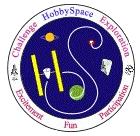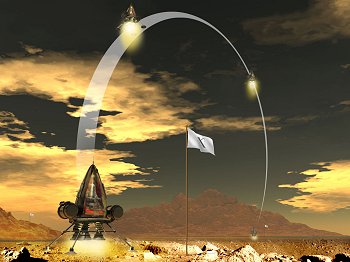 |
|
| |
|
|
|
(Under construction) |
NASA is famous for its use of arcane acronyms and
buzzwords. The NewSpace movement has its own jargon
and buzzwords. This page provides a glossary for many
of these terms.
|
|
-
- see NewSpace
- - A common contracting approach in
NASA and military aerospace programs in which the
contractor is guaranteed a profit as a percentage
of the total contract value. This came about due to
frequent overruns when developing systems based on
new technology that turned out to be more difficult
than expected. In addition, the government agencies
often ask for modifications midway during the development
process, which can drive up costs tremendously.
To insure no cheating, the government requires extensive
auditing of the companies, which in turn must hire
lots of people to maintain detailed records and respond
to the government audits. The agencies in turn must
hire lots of auditors to oversee the companies.
Since their profits depend on the total value of the
contract, the companies are biased towards selecting
the most expensive technologies to fulfill the goals
of the contract.
The cost-plus contract has pushed aerospace programs
to become extremely expensive. Most NewSpace companies
offer a fixed-price and milestone payment approach.
- - An example of this would be a company
building, launching, and operating an asteroid probe
based on a contract from NASA to buy the data that
the spacecraft returns about the asteroid. If the
spacecraft fails, NASA would pay nothing. This has
been proposed as an alternative, services style approach
for NASA and other agencies to obtain space science
data. The advantage for the company is that it would
be able to build the spacecraft as it saw fit rather
than according to the standard NASA procurement environment.
See Fee-for-services.
-
(Expendable Launch Vehicles) - See RLV.
-
- In an example of this approach, NASA would simply
pay for delivery of cargo and crew to orbit instead
of designing, building and operating its own launch
systems. This would incentivise the development of
new launch vehicles while freeing the companies to
use the designs they believed were best rather than
what NASA engineers selected. It would also set in
motion a survival of the fittest process in which
the vehicles that provided the best performance would
win out in the end over less capable ones. The COTS
program for commercial ISS resupply services is NASA
first use of the fee-for-services approach.
- - A contractor agrees to a
fixed price ahead of time for development of the hardware.
This contrasts with the Cost-Plus
approach.
- - A project payment approach in
which the contract gets partial payments as progress
milestones are accomplished within a given time frame.
-
- A term to describe a new approach to space development
based on private, commercial entrepreneurial companies
that make lowering the cost of space technology their
top priority. See the top
page of this section for a full description. Similar
terms:
-
- (also space prizes, competitions, contests, etc.)
- A commonly suggested method for motivating private
development of space hardware and services. Aviation
prizes helped to advanced the field in the 1920s and
1930s. Teams often spend more than the value of the
prize. See, for example, the X
Prize.
-
(Reusable Launch Vehicle) - Most rocket powered vehicles
in use today to reach orbit are Expendable Launch
Vehicles (ELV), meaning they are used just once
and the booster stages are discarded, usually into
the ocean. This is the main contributor to the high
cost of reaching orbit. A vehicle that can be reused
for many flights and with low operational cost (i.e.
minimal maintenance between flights) is neccessary
to drive down the cost of reaching orbit significantly,
especially for human access to space. (Extremely cheap,
throwaway ELVs for bulk cargo such as water and fuel
supplies may be the cheapest approach in some cases.)
Early ELVs derived from missiles, which are basically
artillery. Every ELV is on both its first and last
test flight and first and last operational flight.
Everything must work perfectly and often it does not.
A RLV should allow for incremental testing and fixing
of problems just as is done with airplanes.
The Space Shuttle is often referred to as an RLV but
in fact it is only partially reusable. The huge external
tanks are thrown away and while the solid rocket boosters
are recovered they need extensive refurbishment to
fly again. The orbiter is reused but it also needs
lots of refurbishing between flights (e.g. thousands
of thermal protection tiles must be examined after
every flight). Several thousand people are involved
in preparing a Shuttle for a flight.
A practical RLV will refly within days if not hours.
Major maintenance should only be needed after a large
number of flights. The support staff needs to be small.
A RLV will need a high flight rate to pay back its
investment (unless it was funded by the government).
A bootstrapping problems to obtaining funding for
RLV development has been the lack of a big enough
market to provide for such a payback. However, big
markets won't develop until there is cheap access
to space.
It is hoped that the many RLVs planned for suborbital
spaceflight, most aimed at space tourism, will push
rocket technology towards high reusability and low
operational costs, which can then be applied to orbital
RLVs. Also, these vehicles will help develop and build
markets such as tourism.
The RLV term will become obsolete once such vehicles
become common. We don't call airplanes reusable air
vehicles. Instead, terms like space transport or spaceships
will be used.
See RLV
Resources section.
- - First proposed by Edward Wright and
others as a way to attract public interest in rockets
and also to push the development of reusable rocket
technology the way car racing pushed development of
automobile technology. A racing program based on EZ-Rocket
built by XCOR's
was announced in 2005. See Rocket
Racing League. John Carmack of Armadillo
Aerospace has proposed a design for Vertical Drag
Racing.
-
- One "ultimate extreme sport" that has
been proposed involves individual free fall from high
altitude balloons, suborbital and even orbital vehicles.
The latter would require a personal thermal protection
system such as the MOOSE
manned orbital escape system proposed back in the
1960s by GE.
- - This refers to trajectories that
take a vehicle above the commonly ascribed border
to space around 100km but not into orbit around the
earth. Such trajectories require far less energy than
orbital ones.
- - (Also called Ansari X Prize
after its main sponsor, Anousheh Ansari.) $10M competition
to demonstrate that a privately funded manned reusable
rocket vehicle could make a suborbital space flight
two times within two weeks. Won by SpaceShipOne
built by Burt Rutan and his team at Scaled
Composites. More info at www.xprize.org.
- - Annual rocket and space festival.
The initial motivation was to continue the momentum
begun by the success of the X Prize. The long term
goal is to have teams compete in various rocket related
performance categories. The 2006
event included the Lunar Lander Challenge contest,
though only one team managed to qualify and compete
for the prize. There were also demonstrations of rocket
engine firings, high power rocketry flights, and also
two space elevator related challenge events, which
had multiple competitors. The 2007 event should see
the Rocket
Racing League competition for the first time.
See www.xprizecup.com.
|
|
|
- - The program inspired by the X
PRIZE in which NASA funds purses for competitions
to develop various technologies that support the agency's
long term space exploration plans. See NASA
Centennial Challenges.
- Lunar
Lander Challenge - A competition to demonstrate
some of the rocket vehicle capabilities needed
for transportation getting on and off the Moon.
A vertical takeoff and landing vehicle must carry
a specific payload between two landing pads and
the return to the starting pad, all within a set
time period. See Lunar
Lander Challenge at X Prize Foundation, which
manages the program for NASA.
- :
NASA's name for the all of the vehicles and hardware
involved in the Moon and Mars program.
- Ares
1 -
- Ares
5 -
- CLV - Crew Launch Vehicle - see Ares 1
- CaLV - Cargo Launch Vehicle - see Ares 5
- Orion
- capsule and
- The Stick - a nickname for the Ares 1 due to
the long thin shape of the vehicle design
-
- Commercial Orbital Transportation Services
demonstration - A NASA program to fund private companies
to provide cargo, and eventually crew, delivery services
to the International Space station. Space activists
have for decades urged NASA to use this sort of fee-for-servcices
approach rather than insisting on developing and running
its launch vehicles itself. See the COTS
links for further resources about COTS.
-
- A groundbreaking project that proved that a LOX/LH2
rocket could be flown repeatedly and with a short
turnaround time. Also, it proved that by using X-vehicle
style management, an advanced rocket vehicle project
could be accomplished for a factor of ten less in
cost than with standard NASA/Military procurement.
See DC-X
resources.
-
- Evolved Expendable Launch Vehicles - an Air Force
funded program that includes the Boeing's
Delta IV and Lockheed-Martins
Atlas V families of expendable launch vehicles.
The goal was to build new ELVs that used modern manufacturing
techniques and less complicated lanch operations to
obtain lower cost access to space for the military.
It was also expected that the vehicles would be used
for launching commercial satelllites and thus lower
costs via economies of scale. However, due to a downturn
in the satellite industry instead of an expected expansion,
the commercial use of the EELVs materialized and the
EELVs are actually very expensive.
In hopes of achieving lower costs by reducing duplication,
the two programs were merged in 2006 into the United
Launch Alliance (ULA). This was quite controversial
since it gave ULA a monopoly for several years on
the launching of large military payloads. SpaceX
fought the merger but failed at least partly because
it could not show that it had a competitive system.
The Air Force managed to get Federal Trade Commission
(FTC) approval of the ULA on the basis of national
security needs. There were also various safeguards
that should let SpaceX and other companies bid for
some military payloads once they have vehicles ready.
Unfortunately, there are top space program managers
within the military who expect to use these extrememly
expensive launch vehicles for many decades: EELV
forever? - The Space Review - Sept.11.06
- - A broad term for the various
launchers, spacecraft, and other hardware designed
to fulfill the VSE.
See also Constellation
- ESAS
- (Exploration Systems Architecture Study) - NASA
sponsored study into the types of hardware it
wanted to fulfill the VSE
-
- Vision for Space Exploration - Name for the
policy announced by President Bush on January 14,
2004 that set NASA's long term goals as a return of
humans to the Moon and a mission to Mars. He also
said that the Space Shuttle should be retired by 2010.
Text
and other resources for the VSE.
|
|
|
|
| |
|
|
| |
|
|
|
|
|
|
|



